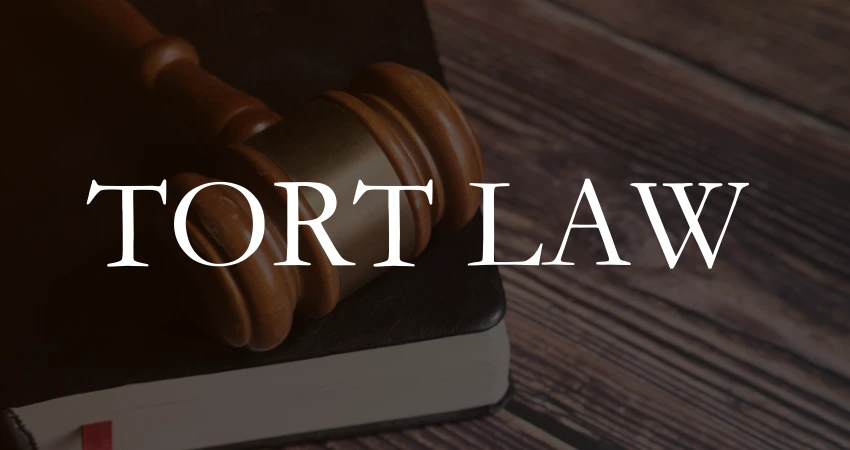Tort law is a branch of law that governs civil cases. Generally, any case presented in civil court, excluding those related to contracts, is categorized under tort law. Legal actions related to agreements are governed by contract law.
The legal concept of tort law is to compensate for a wrong done and offer relief from the harmful actions of others, usually through financial compensation. The primary purpose of tort law is to offer complete restitution for verified damages.
Tort law deals with those who harm others and force them to compensate the affected person or party. These harms include loss of income (past or future), medical costs, and physical and emotional distress compensation. In some cases, additional retributive damages may be awarded to punish the accused above total compensation.
Legal Concepts in Tort Law
- It covers civil cases, regardless of contractual disputes.
- Tort law is also categorized as restorative justice, focusing on addressing harm or damages by providing financial restitution.
- Tort law is divided into three primary categories: claims of negligence, intentional misconduct, and strict liability.
-
Negligent Torts
Negligent torts involve harm to someone caused by another’s failure to apply a required level of care, generally considered a reasonable level of caution. Accidents are a common example of negligent torts.
-
Intentional Torts
Intentional torts refer to harms caused by another person’s deliberate wrongful actions, including offenses like assault, fraud, and theft.
-
Strict Liability Torts
Contrary to negligence or intentional torts, strict liability torts do not examine the party’s fault for causing harm. Rather, they focus on the action itself. If a person or an organization commits a specific action, like manufacturing a defective product, that party is held accountable for any resulting damage, regardless of the care taken or their intent.
Practical Examples of Tort Law
-
A Liability Case
In February 2016, a Google-designed autonomous vehicle collided with a Mountain View, California bus. The car detected a cluster of sandbags placed near a storm drain and moved into an adjacent lane to avoid them, crashing into the side of a public transit bus. It was the first reported accident case of an autonomous car.
Under liability tort law, drivers can pursue compensation from a manufacturer for defective car components, usually an airbag or tire. However, this form of liability now applies to autonomous vehicles as well, clarifying companies like Google and others in the emerging self-driving car industry could be held responsible for any damages.
-
A Negligence Case
Amy Williams initiated a negligence claim against Quest Diagnostics and its subsidiary, Athena Diagnostics, for the unlawful death of her two-year-old son, Christian Millare.
In 2017, Athena Diagnostics misidentified a mutation in Millare’s gene. The accuser contended this error caused the child’s doctors to administer an inappropriate treatment for his symptoms. The mutation directly caused his seizure and subsequent death in 2008.
In 2018, eleven years after the child’s death, the South Carolina Supreme Court determined that a genetic testing laboratory could be considered a healthcare provider according to state legislation.
-
An Intentional Tort Case
On March 18, 2016, an intentional tort example was seen when the court decision involved the website Gawker and professional wrestler Hulk Hogan.
Hogan was granted $140 million in compensation after it was determined that Gawker deliberately violated his privacy by collecting video evidence of a personal act.
Tort Reform
The tort reform issue involves an important position against numerous legal claims, especially in the US. Supporters of this liability law consider that many legal actions nowadays are baseless.
According to data from the Court Statistics Initiative, around 12.5 million civil cases were submitted to state trial courts in the US in 2022. Supporters of liability law changes stated that many of these are founded on weak premises or initiated to threaten or sway results.
These baseless lawsuits are costly and time-consuming, draining public resources that could be more effectively allocated to other areas.
Proponents of liability law reform in the United States have particularly concentrated on legal actions related to medical negligence claims and accusations of billing excesses, including the unnecessary administration of expensive medical tests and the inflated cost of medications due to licenses.
Tort law plays an important role in providing legal recourse for those harmed by others, ensuring that victims receive compensation for damages, including physical injury, emotional distress, or financial losses. Whether through negligence, intentional misconduct, or strict liability, tort law holds wrongdoers accountable to restore justice. However, the growing complexity of modern issues, such as autonomous vehicles and genetic testing errors, highlights the evolving nature of tort law. While tort reform remains a topic of debate, particularly concerning frivolous lawsuits, tort law continues to serve as a foundational pillar in the legal system, addressing harm and encouraging fairness.
Read also: Maintenance and champerty in tort






